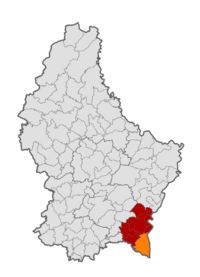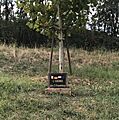Schengen, Luxembourg facts for kids
Quick facts for kids
Schengen
|
|
|---|---|
|
Commune
|
|

A view of Schengen
|
|

Map of Luxembourg with Schengen highlighted in orange, and the canton in dark red
|
|
| Country | |
| Canton | Remich |
| Area rank | ? of 100 |
| Highest elevation | 302 m (991 ft) |
| • Rank | 98th of 100 |
| Lowest elevation | 141 m (463 ft) |
| • Rank | 5th of 100 |
| Population
(1 January 2019)
|
|
| • Total | 4,833 |
| • Rank | 32nd of 100 |
| • Density rank | 101st of 100 |
| Time zone | UTC+1 (CET) |
| • Summer (DST) | UTC+2 (CEST) |
| LAU 2 | LU0001206 |
| Website | schengen.lu |
Schengen is a small village in the country of Luxembourg. It is known for making wine. The village is located in the far south-eastern part of Luxembourg, right next to the Moselle River.
Schengen is special because it's where the borders of three countries meet: Germany, France, and Luxembourg. This meeting point is called a tripoint.
In 2011, Schengen joined with two other areas, Burmerange and Wellenstein. This made the area of the commune larger. A commune is like a local government area or a group of villages.
The commune of Schengen has about 4,223 people living in it. The village of Schengen itself had 679 people in 2024. The commune used to be named after its largest village, Remerschen. But in 2006, its name was changed to Schengen. This was done because Schengen became famous after an important agreement was signed there in 1985.
Schengen also has a historic building called Schengen Castle. It was first built in 1390, but most of what you see today was rebuilt in the 1800s.
Contents
Villages in Schengen
The Schengen commune is made up of several smaller villages. These villages are grouped into three main sections:
|
|
|
Famous People from Schengen
Some notable people have come from the Schengen area:
- Nico Klopp (1894–1930): He was a painter born in Bech-Kleinmacher. He painted beautiful scenes of the Moselle River, where he lived.
- François Valentiny (born 1953): He is a famous architect from Luxembourg. He was born in Remerschen.
Population Growth
The number of people living in the Schengen commune has changed over many years. Here is a chart showing how the population has grown:
The European Museum
The European Museum in Schengen opened on June 13, 2010. This was 25 years after the important Schengen Agreement was signed.
The museum has an exhibition that tells the story of the Schengen Agreements. It explains how these agreements helped remove border checks between many European countries. This means people can travel more freely. The museum shows old photos, videos, and sounds from when the agreement was signed. It also shares what people involved at the time said about it.
Twin Towns
Schengen has a "twin town" or "sister city." This means it has a special friendship with another town in a different country.
 Ischgl, Austria
Ischgl, Austria
Images for kids
See also
 In Spanish: Schengen (Luxemburgo) para niños
In Spanish: Schengen (Luxemburgo) para niños



